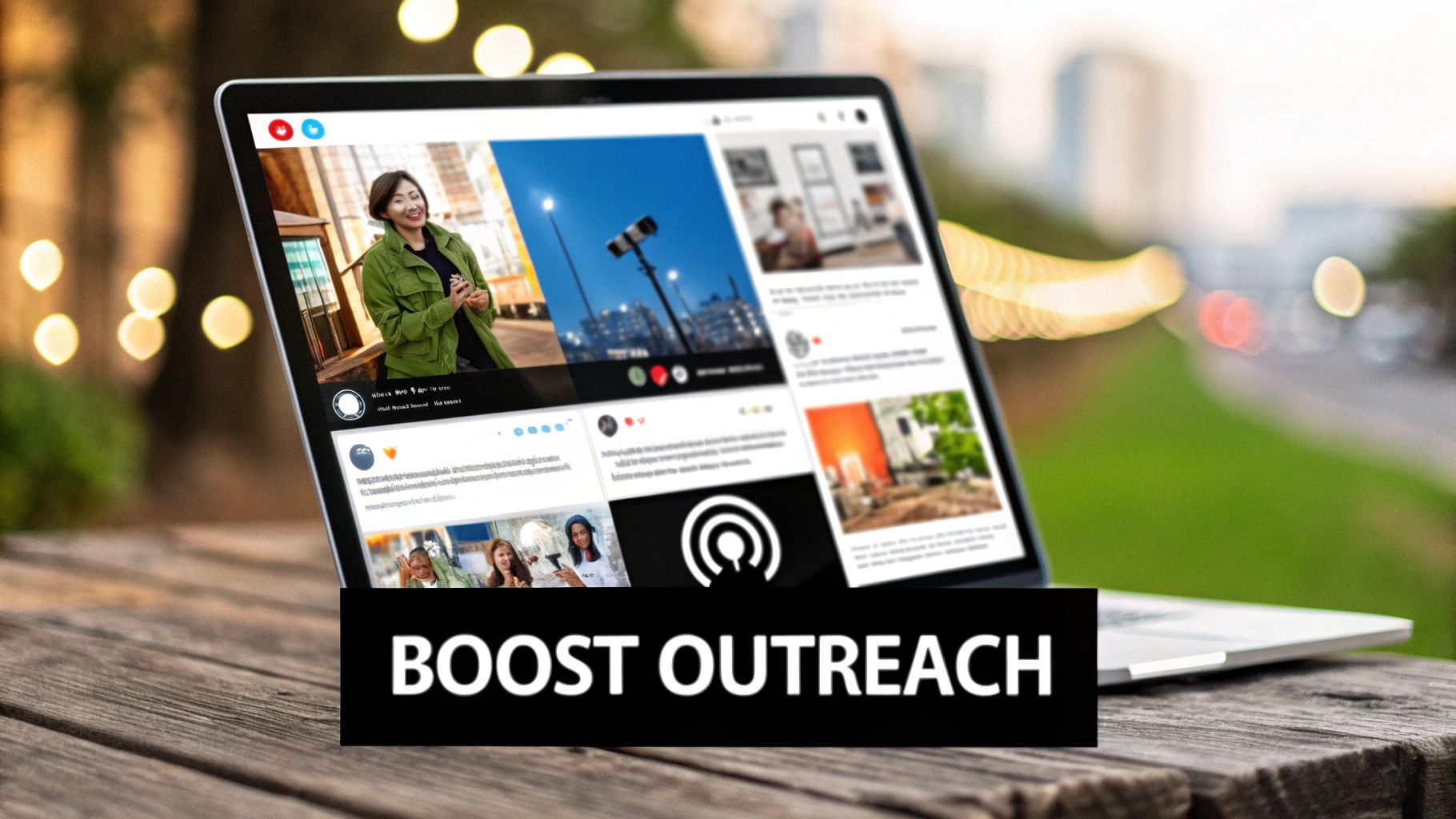
Understanding Today's Podcast Landscape and Growth Opportunities

The podcast industry keeps growing and changing as more people discover this engaging medium. For podcasters looking to build their audience, understanding the current state of podcasting is essential. This means paying attention to how people consume podcasts, what topics are gaining traction, and where opportunities exist to stand out. By studying what works for successful shows, new podcasters can develop strategies that help them thrive.
The numbers tell an exciting story about podcasting's momentum. As of 2023, there are 464.67 million podcast listeners worldwide. This number is expected to reach 504.89 million by the end of 2024 and grow to 630.9 million by 2025. For more details, check out these Podcast Statistics. The consistent growth shows that now is an excellent time to start or grow a podcast, though success requires careful planning and execution.
Identifying Growth Opportunities
Finding the right niche is critical for podcast growth. The best opportunities often lie in topics that have dedicated followers but aren't oversaturated with shows. By focusing on a specific audience and creating content just for them, you're more likely to build a loyal following. Take time to study other podcasts in your area of interest – what do they do well? Where are the gaps you could fill? Understanding this helps you create something unique that stands out.
Adapting to Listener Preferences
To grow your audience, you need to understand what your listeners want. Are they looking for quick, bite-sized episodes or deep conversations? Which formats keep them coming back? For example, some successful podcasts now include video versions of their shows on YouTube, reaching viewers as well as listeners. For more guidance on getting started, read How To Start Podcasting: A Complete Journey From Idea to Launch. Keeping up with how people consume podcasts helps you make smart choices about your show's format and content.
Crafting Content That Captures and Converts Listeners

The heart of growing your podcast audience lies in creating content that truly connects. It's not just about planning episodes – you need to craft an experience that speaks to your listeners and makes them eager to tune in next time. This means carefully choosing topics, structuring episodes effectively, and maintaining a reliable schedule that your audience can count on.
Developing a Content Strategy
A clear content strategy acts as your podcast's compass. Start by really getting to know your target listeners – what problems do they face? What information are they seeking? For example, if you run an entrepreneurship podcast, your audience likely wants practical advice about starting businesses, marketing tactics, and managing work-life balance.
Think about your format too. You might do solo episodes where you share your expertise, bring on guests for interviews, or mix it up with different styles. Test different approaches to see what your listeners respond to best. Having variety in your content calendar helps keep your show fresh and your audience engaged.
Creating Compelling Narratives
Even for non-fiction shows, storytelling matters. Give each episode a clear beginning that hooks listeners, a middle that explores your topic in depth, and an ending that leaves them with valuable takeaways. For instance, you might open by describing a common challenge, discuss various solutions, and close with actionable steps listeners can implement.
Being genuine is essential for building trust with your audience. Let your real personality come through rather than trying to sound overly polished. Share your own experiences and perspectives. This helps create a genuine connection that turns casual listeners into devoted fans.
Maintaining Production Quality
While great content is crucial, sound quality can make or break your show. Invest in proper recording gear and editing tools to achieve professional-grade audio. Poor sound will drive listeners away, no matter how interesting your topic. Good production values show respect for your audience and enhance their listening experience.
Don't let the pursuit of perfection prevent you from publishing consistently though. Find a sustainable balance between quality and regular releases. Stick to a predictable schedule that works for you – whether that's weekly, bi-weekly or monthly. This reliability builds anticipation and helps boost your visibility on platforms like Apple Podcasts and Spotify. Success comes from combining compelling content, reliable delivery, and solid production standards to create a show that stands out in your niche.
Maximizing Your Show's Distribution and Visibility

Getting your podcast in front of more listeners takes smart distribution. Just like a storefront needs foot traffic, your podcast needs to be easily discoverable by your target audience. Success requires more than just uploading episodes – you need a clear plan to expand your reach through multiple channels.
Leveraging Multiple Platforms
Every major podcast platform has unique listeners who could become fans of your show. While Apple Podcasts and Spotify are essential starting points, don't stop there. Submit your show to Stitcher, Google Podcasts, and niche directories that match your topic. For best results, customize your show's description and artwork for each platform's specific audience.
Optimizing Your Presence
Being listed on platforms is just the first step. Make your podcast stand out with an attention-grabbing description that quickly communicates your show's value. Use clear, descriptive titles and relevant keywords to help potential listeners find you through search. Professional cover art and compelling episode descriptions significantly impact your podcast's discoverability.
Strategic Partnerships and Cross-Promotion
Working with other podcasters and brands can rapidly grow your audience. Guest on related shows and invite other hosts to join your episodes. Look for partnership opportunities with businesses whose audiences align with yours. For example, a fitness podcast could team up with a nutrition company to share audiences. These collaborations create win-win situations that benefit everyone involved.
Repurposing Content and Expanding Visibility
Make your podcast content work harder by transforming it into different formats. Turn interesting clips into social media videos, convert episodes into blog posts, or compile key takeaways for your email list. This approach helps you reach people who prefer different content types. A multi-platform strategy lets you connect with potential listeners wherever they spend time online. You might be interested in: How to master your Social Media strategy.
Exploring Untapped Distribution Channels
Look beyond traditional podcast directories to find your audience. Share relevant episode clips in online communities and social media groups where your target listeners gather. Join discussions related to your show's topics to build genuine connections. By understanding where your ideal listeners spend time online, you can place your content directly in front of them. This focused approach helps you build an engaged community of dedicated fans who keep coming back for more.
Building a Thriving Listener Community

Success in podcasting goes far beyond download numbers – it's about creating real connections with your listeners. When you build genuine relationships with your audience, they become more than passive listeners – they turn into engaged participants who help spread the word about your show. Here's how to build those meaningful connections that transform casual listeners into devoted fans.
Encouraging Listener Participation
Getting your listeners involved starts with direct invitations to engage. During episodes, pose thoughtful questions and ask listeners to share their perspectives on social media using your show's hashtag. Create polls about future topics and host Q&A sessions where listeners can guide the conversation. When people feel their input shapes the show, they develop a sense of investment in its success.
Facilitating Meaningful Discussions
To really build community, you need spaces for listeners to connect with you and each other. Consider setting up a Facebook group or Discord server dedicated to your show's themes and topics. Stay active in these spaces by responding to comments and guiding conversations. Keep discussions respectful and on-topic while encouraging different viewpoints. A well-moderated community helps listeners feel heard and valued.
Creating Memorable Experiences
Take your show beyond just audio by organizing special events that bring listeners together. This could be live episode recordings, virtual meetups, or exclusive bonus content for dedicated fans. For example, host a live Q&A session or organize an online listening party for season premieres. These shared experiences help listeners connect with each other while strengthening their bond with your show.
Leveraging User-Generated Content and Managing Feedback
Make your listeners part of the show by featuring their contributions. Ask them to send in questions, stories, and audio clips to include in episodes. Not only does this provide great content, but it shows you value their input. Set up clear channels for feedback through surveys and dedicated email addresses. Then actually use that feedback to improve – it shows listeners you take their suggestions seriously.
Scaling Community Management
As your listener base grows, you'll need systems to manage engagement effectively. Create clear community guidelines, use moderation tools, and consider bringing on help to maintain consistent interaction with listeners. Focus on fostering real connections through valuable content and genuine engagement. While building community takes ongoing effort, an active and loyal audience becomes one of your show's greatest assets.
Using Data to Drive Strategic Growth Decisions
Growing your podcast audience requires smart decisions based on real data, not guesswork. When you understand what your analytics are telling you, you can turn those insights into specific actions that help your show grow. The key is focusing on the right metrics and knowing how to use that information to make your podcast better.
Key Metrics for Podcast Growth
To make informed decisions about your podcast, you'll want to track several important performance indicators that show how your show is really doing:
- Downloads: While just one piece of the puzzle, your download numbers give you a basic sense of your reach. Look at which episodes get the most downloads to spot what content resonates.
- Unique Listeners: This tells you how many different people actually tune in, giving you a clearer view than raw downloads alone.
- Listener Completion Rate: See how much of each episode people actually finish – higher rates mean your content keeps them engaged.
- Website Traffic: Track how many visitors come to your site from your podcast to measure cross-platform impact.
- Social Media Engagement: Watch for mentions, shares and comments about your show to gauge audience response and find community-building opportunities.
Analyzing Listener Behavior and Preferences
The real value of data comes from understanding your audience's habits and interests. Your analytics can reveal when people listen, what content they prefer, and who they are demographically. For example, if episodes with certain guests or topics consistently get more listeners, that's a clear signal to feature similar content. You can then plan future episodes around what you know works for your specific audience.
Optimizing Your Show Based on Performance Data
Take what you learn from your data and make practical improvements. This might mean adjusting your content calendar to focus on topics that perform well, trying new episode formats based on completion rates, or focusing your promotion on platforms that bring in the most listeners. When you know where your efforts pay off best, you can focus your time and resources there.
Setting Up Tracking Systems and Creating Data-Driven Growth Plans
Start by using the analytics tools from your hosting platform or dedicated tracking services. These make it simple to collect data and generate reports you can actually use. Then create specific growth plans targeting areas that need work. For example, if completion rates are low, set a goal to improve them by testing shorter episodes or tightening up your storytelling. Review your results regularly and adjust your approach based on what the data shows. This ongoing cycle of measuring, learning and improving helps your podcast grow steadily and sustainably.
Developing Revenue Streams That Support Sustainable Growth
Growing a profitable podcast starts with finding the right ways to make money while keeping your audience happy. The key is adding revenue sources that fit naturally with your content and provide real value to listeners, not just pushing ads at them. It's all about thinking of monetization as part of your overall content approach.
Sponsorships That Enhance, Not Interrupt
While sponsorships are a common way to earn money podcasting, they need a thoughtful approach. Focus on integrating sponsor messages naturally into your show rather than running generic ads. For instance, if you host a fitness podcast, partner with brands selling workout gear or healthy meal services. When sponsors align with your topic, their mentions feel helpful rather than disruptive. The goal is finding partners who make your content better, not just fill ad time.
Premium Content: Offering Exclusive Value
Creating premium content gives dedicated listeners special access while generating steady income. This could mean ad-free episodes, bonus segments, early access to new shows, or custom merchandise. Think of it as a VIP experience for your biggest fans. Not only does this bring in revenue, but it also builds a stronger connection with your core audience. The result is loyal listeners who feel valued while providing reliable income.
Diversifying Income: Exploring Additional Avenues
Look beyond just sponsorships and premium content for more ways to earn that match your podcast's focus. Try affiliate marketing by recommending relevant products and earning commissions. You can also design and sell branded items like shirts or mugs to both make money and strengthen your brand identity. For more ideas, check out How to master your podcast monetization strategy. Just be careful not to overload listeners with too many promotions. Finding the right balance between valuable content and money-making opportunities is essential.
Evaluating and Implementing Monetization Opportunities
Before starting any new revenue stream, think about how it will impact your audience. Look at factors like listener demographics, what content they prefer, and their overall experience. For example, expensive premium memberships might not work well if most listeners are students. Test different approaches to see what resonates without turning people away. This helps ensure your monetization actually helps grow your podcast rather than hurting it.
Ready to take your podcast further? Visit Jason Yormark to learn how to build a thriving and sustainable podcasting business.


Leave a Reply